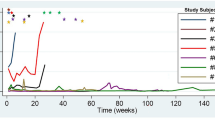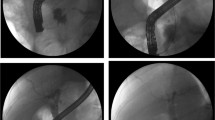Abstract
Background
Endoscopic ablation of duodenal ampullary malignancy has not been fully assessed.
Aims
The study aimed to evaluate the efficacy and safety of Endoscopic retrograde cholangiopancreatograpy (ERCP)-guided radiofrequency ablation (RFA) for inoperable ampullary cancer.
Methods
Patients with inoperable ampullary cancer underwent ERCP-guided RFA from January 2012 to August 2017. RF energy (7–10 W) was delivered using bipolar RFA electrodes under endoscopic guidance. RFAs were repeated every 1–3 months until visible tumor was eliminated. All patients were followed up till June 2018, during which any biliary event was noted and managed endoscopically.
Results
Twenty-three patients underwent a median of two RFA sessions (range 1–6) at a median interval of 56 (range 35–90) days. Among 18 (78.3%) patients who received endoscopic re-evaluations, nine patients showed no remaining lesion and nine showed more than 50% tumor size reduction. During a median follow-up duration of 517 days (range 60–1836 days), eight (34.8%) patients required endoscopic re-interventions. The re-intervention rate at 6 months after RFA was 36.8%. Twelve patients were alive, among whom six required no biliary stenting. The accumulative mean survival was 1081 (95% CI 757.8–1404.0) days. RFA-related adverse events occurred in four cases (7.7%) including mild pancreatitis (1), bleeding (1), and late distal biliary stenosis (2).
Conclusion
This pilot study shows that ERCP-guided RFA is safe to use and able to reduce tumor volume and re-interventions in patients with inoperable ampullary cancer.


Similar content being viewed by others
References
Ahn DH, Bekaii-Saab T. Ampullary cancer: an overview. Am Soc Clin Oncol Educ Book. 2014;2014:112–115. https://doi.org/10.14694/EdBook_AM.2014.34.112.
Feretis M, Wang T, Iype S, et al. Development of a prognostic model that predicts survival after pancreaticoduodenectomy for ampullary cancer. Pancreas. 2017;46:1314–1321.
Lemke J, Schafer D, Sander S, Henne-Bruns D. Kornmann M (2014) Survival and prognostic factors in pancreatic and ampullary cancer. Anticancer Res. 2014;34:3011–3020.
Mensah ET, Martin J, Topazian M. Radiofrequency ablation for biliary malignancies. Curr Opin Gastroenterol. 2016;32:238–243.
Sofi AA, Khan MA, Das A, et al. Radiofrequency ablation combined with biliary stent placement versus stent placement alone for malignant biliary strictures: a systematic review and meta-analysis. Gastrointest Endosc. 2018;87:e941.
Zheng X, Bo ZY, Wan W, et al. Endoscopic radiofrequency ablation may be preferable in the management of malignant biliary obstruction: a systematic review and meta-analysis. J Dig Dis. 2016;17:716–724.
Kadayifci A, Atar M, Forcione DG, Casey BW, Kelsey PB, Brugge WR. Radiofrequency ablation for the management of occluded biliary metal stents. Endoscopy. 2016;48:1096–1101.
Yoon SM, Kim MH, Kim MJ, et al. Focal early stage cancer in ampullary adenoma: surgery or endoscopic papillectomy? Gastrointest Endosc. 2007;66:701–707.
Rustagi T, Irani S, Reddy DN, et al. Radiofrequency ablation for intraductal extension of ampullary neoplasms. Gastrointest Endosc. 2017;86:170–176.
Sharaiha RZ, Natov N, Glockenberg KS, Widmer J, Gaidhane M, Kahaleh M. Comparison of metal stenting with radiofrequency ablation versus stenting alone for treating malignant biliary strictures: is there an added benefit? Dig Dis Sci. 2014;2014:3099–3102.
Sharaiha RZ, Sethi A, Weaver KR, et al. Impact of radiofrequency ablation on malignant biliary strictures: results of a collaborative registry. Dig Dis Sci. 2015;60:2164–2169.
Kallis Y, Phillips N, Steel A, et al. Analysis of endoscopic radiofrequency ablation of biliary malignant strictures in pancreatic cancer suggests potential survival benefit. Dig Dis Sci. 2015;60:3449–3455.
Schmidt A, Bloechinger M, Weber A, et al. Short-term effects and adverse events of endoscopically applied radiofrequency ablation appear to be comparable with photodynamic therapy in hilar cholangiocarcinoma. United Eur Gastroenterol J. 2016;4:570–579.
Laleman W, van der Merwe S, Verbeke L, et al. A new intraductal radiofrequency ablation device for inoperable biliopancreatic tumors complicated by obstructive jaundice: the IGNITE-1 study. Endoscopy. 2017;49:977–982.
Yang J, Wang J, Zhou H, et al. Efficacy and safety of endoscopic radiofrequency ablation for unresectable extrahepatic cholangiocarcinoma: a randomized trial. Endoscopy. 2018;50:751–760.
Laquiere A, Boustiere C, Leblanc S, Penaranda G, De´silets E, Prat F. Safety and feasibility of endoscopic biliary radiofrequency ablation treatment of extrahepatic cholangiocarcinoma. Surg Endosc. 2016;30:1242–1248.
Camus M, Napoléon B, Vienne A, et al. Efficacy and safety of endobiliary radiofrequency ablation for the eradication of residual neoplasia after endoscopic papillectomy: a multicenter prospective study. Gastrointest Endosc. 2018;88:511–518.
Park SB, Kim HW, Kang DH, et al. Metallic or plastic stent for bile duct obstruction in ampullary cancer? Dig Dis Sci. 2012;57:786–790.
Acknowledgments
This study was partially supported by funding from the Shanghai Outstanding Medical Academic Leader Program (2015-83).
Author information
Authors and Affiliations
Contributions
BH performed conception and design of the study, clinical practice, and critical revision of the article. BS drafted the article. JW contributed to analysis and interpretation of data. BH, JW, DG, XY, MX, and TW were involved in clinical practice and data collection. All authors approved the publication of this article.
Corresponding author
Ethics declarations
Conflict of interest
All authors declare that they have no conflict of interest.
Informed consent
The study was approved by the institutional review board of the hospital. Patients provided written informed consent to participate in the study before the endoscopic radiofrequency ablation procedure.
Additional information
Publisher's Note
Springer Nature remains neutral with regard to jurisdictional claims in published maps and institutional affiliations.
Rights and permissions
About this article
Cite this article
Hu, B., Sun, B., Gao, DJ. et al. Initial Experience of ERCP-Guided Radiofrequency Ablation as the Primary Therapy for Inoperable Ampullary Carcinomas. Dig Dis Sci 65, 1453–1459 (2020). https://doi.org/10.1007/s10620-019-05849-3
Received:
Accepted:
Published:
Issue Date:
DOI: https://doi.org/10.1007/s10620-019-05849-3




